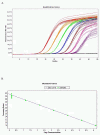Development of a real-time quantitative PCR assay for detection of a stable genomic region of BK virus
- PMID: 21034442
- PMCID: PMC2989966
- DOI: 10.1186/1743-422X-7-295
Development of a real-time quantitative PCR assay for detection of a stable genomic region of BK virus
Abstract
Background: BK virus infections can have clinically significant consequences in immunocompromised individuals. Detection and monitoring of active BK virus infections in certain situations is recommended and therefore PCR assays for detection of BK virus have been developed. The performance of current BK PCR detection assays is limited by the existence of viral polymorphisms, unknown at the time of assay development, resulting in inconsistent detection of BK virus. The objective of this study was to identify a stable region of the BK viral genome for detection by PCR that would be minimally affected by polymorphisms as more sequence data for BK virus becomes available.
Results: Employing a combination of techniques, including amino acid and DNA sequence alignment and interspecies analysis, a conserved, stable PCR target region of the BK viral genomic region was identified within the VP2 gene. A real-time quantitative PCR assay was then developed that is specific for BK virus, has an analytical sensitivity of 15 copies/reaction (450 copies/ml) and is highly reproducible (CV ≤ 5.0%).
Conclusion: Identifying stable PCR target regions when limited DNA sequence data is available may be possible by combining multiple analysis techniques to elucidate potential functional constraints on genomic regions. Applying this approach to the development of a real-time quantitative PCR assay for BK virus resulted in an accurate method with potential clinical applications and advantages over existing BK assays.
Figures



Similar articles
-
Comparative evaluation of laboratory developed real-time PCR assays and RealStar(®) BKV PCR Kit for quantitative detection of BK polyomavirus.J Virol Methods. 2016 Aug;234:80-6. doi: 10.1016/j.jviromet.2016.04.009. Epub 2016 Apr 16. J Virol Methods. 2016. PMID: 27091098
-
Reevaluating and optimizing polyomavirus BK and JC real-time PCR assays to detect rare sequence polymorphisms.J Clin Microbiol. 2011 Apr;49(4):1382-8. doi: 10.1128/JCM.02008-10. Epub 2011 Feb 16. J Clin Microbiol. 2011. PMID: 21325560 Free PMC article.
-
Analytical and clinical performance characteristics of the Simplexa BK virus quantitative PCR assay for the diagnosis of polyomavirus-associated nephropathy in renal transplant recipients using plasma and urine specimens.J Clin Virol. 2012 Dec;55(4):310-6. doi: 10.1016/j.jcv.2012.08.016. Epub 2012 Sep 11. J Clin Virol. 2012. PMID: 22975084
-
Monitoring of BK viral load in renal allograft recipients by real-time PCR assays.Am J Clin Pathol. 2010 Feb;133(2):242-50. doi: 10.1309/AJCP63VDFCKCRUUL. Am J Clin Pathol. 2010. PMID: 20093233 Review.
-
Quantitative real-time polymerase chain reaction for evaluating DNAemia due to cytomegalovirus, Epstein-Barr virus, and BK virus in solid-organ transplant recipients.Clin Infect Dis. 2007 Oct 15;45(8):1056-61. doi: 10.1086/521909. Epub 2007 Sep 12. Clin Infect Dis. 2007. PMID: 17879925 Review.
Cited by
-
Specific and quantitative detection of Human polyomaviruses BKPyV and JCPyV in the healthy Pakistani population.Virol J. 2017 Apr 24;14(1):86. doi: 10.1186/s12985-017-0752-2. Virol J. 2017. PMID: 28438210 Free PMC article.
-
The impact of FDA-cleared molecular solutions for BK polyomavirus quantitation.J Clin Microbiol. 2025 Mar 12;63(3):e0034824. doi: 10.1128/jcm.00348-24. Epub 2025 Jan 17. J Clin Microbiol. 2025. PMID: 39818950 Free PMC article. Review.
-
Evaluating the Efficiency of the Cobas 6800 System for BK Virus Detection in Plasma and Urine Samples.Diagnostics (Basel). 2023 Sep 4;13(17):2860. doi: 10.3390/diagnostics13172860. Diagnostics (Basel). 2023. PMID: 37685397 Free PMC article.
-
Toward standardization of BK virus monitoring: evaluation of the BK virus R-gene kit for quantification of BK viral load in urine, whole-blood, and plasma specimens.J Clin Microbiol. 2014 Dec;52(12):4298-304. doi: 10.1128/JCM.02031-14. Epub 2014 Oct 8. J Clin Microbiol. 2014. PMID: 25297334 Free PMC article.
References
-
- Knowles WA. Discovery and epidemiology of the human polyomaviruses BK virus (BKV) and JC virus (JCV) Adv Exp Med Biol. 2006;577:19–45. full_text. - PubMed
-
- Lundstig A, Dillner J. Serological diagnosis of human polyomavirus infection. Adv Exp Med Biol. 2006;577:96–101. full_text. - PubMed
-
- Khalili K, Stoner GL. Human polyomaviruses: molecular and clinical perspectives. 1. New York: Wiley; 2001.
-
- Hirsch HH, Brennan DC, Drachenberg CB, Ginevri F, Gordon J, Limaye AP, Mihatsch MJ, Nickeleit V, Ramos E, Randhawa P. et al.Polyomavirus-associated nephropathy in renal transplantation: interdisciplinary analyses and recommendations. Transplantation. 2005;79:1277–1286. doi: 10.1097/01.TP.0000156165.83160.09. - DOI - PubMed
Publication types
MeSH terms
Substances
LinkOut - more resources
Full Text Sources
Other Literature Sources

